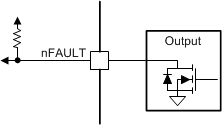JAJSFZ9B October 2017 – January 2021 DRV8873-Q1
PRODUCTION DATA
- 1 特長
- 2 アプリケーション
- 3 概要
- 4 Revision History
- 5 Pin Configuration and Functions
- 6 Specifications
-
7 Detailed Description
- 7.1 Overview
- 7.2 Functional Block Diagram
- 7.3 Feature Description
- 7.4 Device Functional Modes
- 7.5 Programming
- 7.6 Register Maps
- 8 Application and Implementation
- 9 Power Supply Recommendations
- 10Layout
- 11Device and Documentation Support
- 12Mechanical, Packaging, and Orderable Information
パッケージ・オプション
メカニカル・データ(パッケージ|ピン)
- PWP|24
サーマルパッド・メカニカル・データ
- PWP|24
発注情報
7.3.1.8 nFAULT Pin
The nFAULT pin has an open-drain output and should be pulled up to a 5-V or 3.3-V supply. When a fault is detected, the nFAULT line is logic low. For a 5-V pullup the nFAULT pin can be tied to the DVDD pin with a resistor (see the Section 8 section). For a 3.3-V pullup, an external 3.3-V supply must be used.
 Figure 7-10 nFAULT Pin
Figure 7-10 nFAULT PinDuring the device power-up sequence, or when exiting sleep mode, the nFAULT pin is held low until the digital core is alive and functional. This low level signal on the nFAULT line does not represent a fault condition. The signal can be used by the external MCU to determine when the digital core of the device is ready; however, this does not mean that the device is ready to accept input commands via the INx pins.